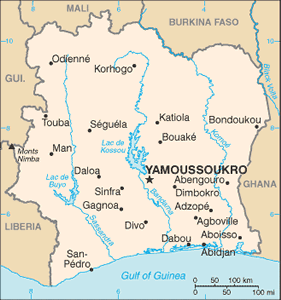The Geography of Cote d'Ivoire
The Geography of Cote d'Ivoire
Ivoirian Geography
Location: Western Africa, bordering the North Atlantic Ocean, between Ghana and Liberia
Geographic coordinates: 8 00 N, 5 00 W
Map references: Africa
Area: total: 322,460 sq km land: 318,000 sq km water: 4,460 sq km
Area - comparative: slightly larger than New Mexico
Land boundaries: total: 3,110 km border countries: Burkina Faso 584 km, Ghana 668 km, Guinea 610 km, Liberia 716 km, Mali 532 km
Coastline: 515 km
Maritime claims: territorial sea: 12 nm exclusive economic zone: 200 nm continental shelf: 200 nm
Climate: tropical along coast, semiarid in far north; three seasons - warm and dry (November to March), hot and dry (March to May), hot and wet (June to October)
Terrain: mostly flat to undulating plains; mountains in northwest
Elevation extremes: lowest point: Gulf of Guinea 0 m highest point: Mont Nimba 1,752 m
Natural resources: petroleum, natural gas, diamonds, manganese, iron ore, cobalt, bauxite, copper, gold, nickel, tantalum, silica sand, clay, cocoa beans, coffee, palm oil, hydropower
Land use: arable land: 10.23% permanent crops: 11.16% other: 78.61% (2005)
Irrigated land: 730 sq km (2003)
Natural hazards: coast has heavy surf and no natural harbors; during the rainy season torrential flooding is possible
Environment - current issues: deforestation (most of the country's forests - once the largest in West Africa - have been heavily logged); water pollution from sewage and industrial and agricultural effluents
Environment - international agreements: party to: Biodiversity, Climate Change, Climate Change-Kyoto Protocol, Desertification, Endangered Species, Hazardous Wastes, Law of the Sea, Marine Dumping, Ozone Layer Protection, Ship Pollution, Tropical Timber 83, Tropical Timber 94, Wetlands, Whaling signed, but not ratified: none of the selected agreements
Geography - note: most of the inhabitants live along the sandy coastal region; apart from the capital area, the forested interior is sparsely populated


